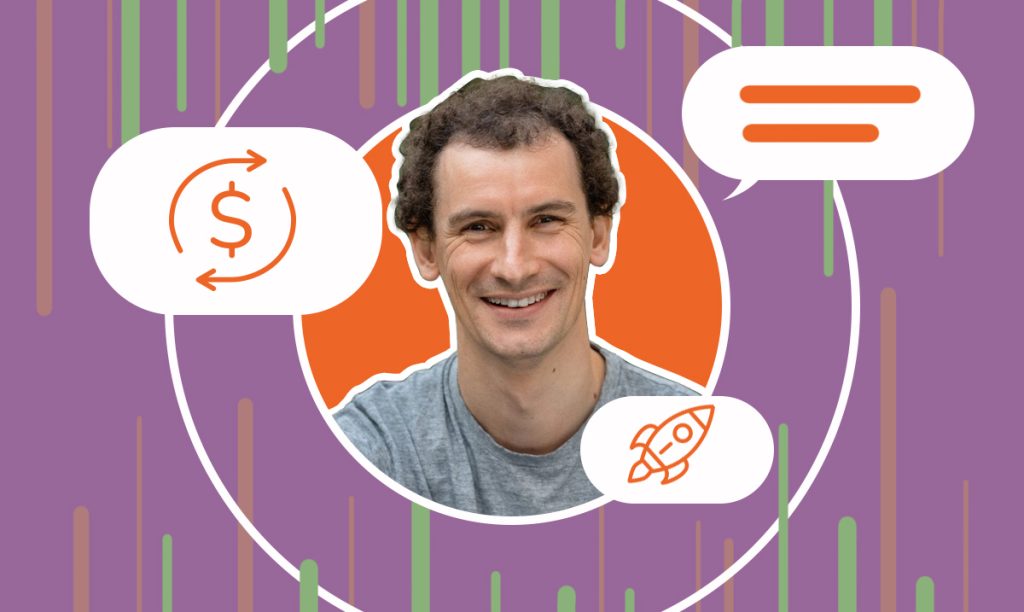In this interview, we sit down with Matthew Reid, the founder of PriceWell, a no-code platform designed to simplify subscription billing forbusiness ...
How No Code Map App Delivers Custom Maps Without Coding
Written by: Esther Strauss
Esther is a business strategist with over 20 years of experience as an entrepreneur, executive, educator, and management advisor.
Published on April 3, 2025

In this interview, we sit down with Nan Zhou, co-founder of No Code Map App, to discuss how she and her team transformed a trip-planning map interface into a powerful no-code solution for businesses needing dynamic maps. Nan explains the early spark for the idea, their approach to AI integration, and the bootstrap journey that led to securing paying customers from day one. She also highlights how their subscription model, user feedback, and constant innovation shape the company’s growth trajectory.
SBS – How did you come up with the idea for No Code Map App, and what early validation steps did you take before building it?
Nan – Before COVID, Ted (my cofounder) and I built a trip-planning app together, and it had this awesome map interface. Towards the end of COVID, a few businesses asked us if they could license the map interface and customise it with their business data and branding. They had spoken to developers about building a custom map, and it was just too expensive (quoted US$20–50k, depending on the complexity). But the app wasn’t designed to be customisable. So, we knew it had to be a separate tool built from scratch.
After some quick research, we decided to build a fully customisable no-code map builder. We had been working with maps for years already, so we were able to build something very quickly. We got paying customers right away.
SBS – Who is your ideal customer, and how did you identify the most promising use cases for an AI-powered map builder?
Nan – Based on our current product and feature offering, our ideal customer would be mid-size companies (so no lengthy approval process) in an industry where:
- locations matter
- there are a lot of locations to map
- the proprietary database exists (not easily searchable on Google)
- the database is constantly updating (demand for a dynamic map)
Obvious examples would be real estate, specialty consumer/retail, and healthcare.
SBS – What differentiates NoCodeMapApp from other no-code or low-code mapping solutions on the market today?
Nan – Compared to the low-code or established GIS tools, we are significantly easier to use — completely no code and fully automated — and compared to other no-code mapping solutions, we are significantly more powerful, especially in terms of data handling and database integration. We are the only no-code map builder fully integrated with Google Sheets, Airtable, and Webflow CMS, plus automatic data sync.
SBS – Could you share more about the underlying technology or AI that drives your map-building process? How do you ensure it remains user-friendly for non-technical users?
Nan – What truly sets us apart is our laser focus on simplifying the very first step of map creation: getting your data in. We realized that this is often the biggest hurdle for people who could really benefit from visualizing their location data. So, we’ve made it incredibly easy. For instance, if you already have your data in Airtable, Google Sheets, or even a Webflow collection, you can connect it to our tool and have a map ready in minutes.
We’re also leveraging the power of AI to make this data import even smoother. Imagine this: you upload your data, and our AI automatically understands what kind of information is in each column, whether it’s addresses, currencies, website links, or even potentially messy data. This allows us to present your map intelligently in the best possible way without you needing to configure anything. For example, if we detect a date column, we’ll automatically set up the right date filters on your map.
We’re taking that ease-of-use even further with map styling. Forget complicated menus! Our users can simply tell us what they want to change. Just yesterday, someone asked us how to change the ocean’s color. We told them just to type: “Change ocean color to whichever code you need,” and it’s done! It’s that intuitive.
SBS – What made you focus on integrations with Google Sheets, Airtable, and Webflow CMS, and do you plan on adding more integrations or partnerships in the future?
Nan – We started with just allowing users to copy and paste in data, then we quickly realised a lot of people have their data stored in no-code databases like Google Sheets, Airtable, and Webflow CMS, so integration with them was an easy decision. Full database integration also means that they can set up auto-data sync, making data updates a breeze.
The goal is to be able to integrate with any database, including internal databases, so people can map any data, regardless of where it is stored.
SBS – How do you currently monetize NoCodeMapApp (e.g., subscription tiers, usage-based pricing, or one-time fees)? Have you experimented with different pricing models?
Nan – We operate on a subscription model. It was quite clear from the beginning that the subscription model is the way to go.
SBS – Which marketing channels or tactics have been most effective for acquiring new users, and how do you plan on scaling your user base moving forward?
Nan – To date, we have not done any paid marketing, so all of our traffic has been organic. The two most effective channels have been Google Search and Twitter. We currently rank no.1 for all “no code map” related terms. Twitter has also been awesome. I have met a lot of like-minded and helpful people while building the No Code Map App in public. I have also been invited to online chats and interviews.
SBS – What were some of the biggest challenges you faced early on — whether technical, financial, or operational — and how did you overcome them?
Nan – I think every early-stage startup (bootstrapped or funded) will face challenges on all fronts. We are constantly learning new things about the problem we are trying to solve, and in our case, with limited resources because we are still bootstrapped. We have to be very mindful of where we spend our limited resources and how to be super scrappy.
SBS – Have you bootstrapped the business, or have you raised external funding? How did you decide on this path, and what advice would you give to others debating the same decision?
Nan – We have just started raising our seed round. We spent the last two years bootstrapped because we wanted to explore this space and try to understand the big picture problem. We now have a clear vision of the problem and believe it is time we raised money.
My advice would be that money is important because you need time and resources to build. We were lucky that we didn’t need much upfront investment with all the different free credits and free subscription tiers. That gave us time to learn our problem and get early paying users. We also needed time to see the big picture and get a clear vision. But if you are already clear on the problem and your vision and your idea/product needs upfront investment, then raise early, as a lot of my friends did. Do what feels right. But fundraising itself is a big challenge and basically a full-time job, so bear that in mind too.
SBS – How have you structured your team to develop, market, and support the product? What are the key roles that have been essential to your growth?
Nan – It’s just Ted (my cofounder) and I. Ted codes and builds, and I sell (so marketing, user communication). We would design our product and features together based on what he knows and what I have learned from our users.
SBS – In handling customer data, what measures do you take to ensure data privacy and compliance with relevant regulations?
Nan – It’s something that we are still working on. We’re following GDPR so that users have full ownership and rights to their data.
Now that we are trying to make it bigger than just a hobby project that it’s been, we are also updating our code such that we help to make sure we minimize the amount of users’ data exposed to the public.
For example, on data integration, we’re trying to have a more complete integration with Google Drive so that users’ data don’t have to be made public before they can be made available to us, but it’s a long application process, so we are still working on that.
SBS – Where do you see the role of AI in no-code solutions heading in the next few years, and how do you plan to keep NoCodeMapApp’s AI capabilities competitive?
Nan – With AI, no-code solutions will be smarter and much more intuitive to use. That has been consistent with our vision all along, so incorporating AI was the natural decision for us going forward.
It’s obvious that every no-code app is going to try to “AI” their existing features, so we expect to see AI features on the front page of all no-code landing pages. It’s going to be exciting to see what people come up with.
We are going to do the same — continue to infuse AI in all of the features we build (not just blindly adding AI everywhere) to make it ever so simpler & faster for our users to build a cool map. Our creativity and our focus on our users are what’s going to keep us competitive, I believe.
SBS – What market or technological trends do you keep an eye on, and how do you adapt your roadmap to remain agile in a rapidly evolving space?
Nan – AI being the obvious one, we are still trying to figure out how to best use AI to our advantage. We’ve been thinking a lot about its potential application in everything we do in the digital map space.
We are also constantly monitoring how maps are visualised on the web and how they can be interactive in all kinds of devices like desktops, mobile phones, iPads, or interactive kiosks. We are always exploring how maps can be useful in different ways and made available to everyone.
Our strategy for remaining agile is pretty simple. We closely observe how our users are interacting with the platform, the creative ways they’re using it, and their feedback.
Subscribe to Our Newsletter
and gain insider access to cutting-edge business insights and trends.
Featured Resources

How PriceWell Transforms Subscription with No-Code Solutions
Published on January 10, 2025
Read Now

How One No-Code AI Tool is Changing the Game for Excel Users
Published on August 19, 2024
Meet David Bressler, the visionary founder behind Formula Bot, an AI-powered tool that has dramatically simplified the way Excel users manage theird ...
Read Now

Navigating the No-Code Era: Jesus Vargas on Empowering Startups
Published on November 28, 2023
The rise of low-code/no-code platforms is revolutionizing the way entrepreneurs and businesses approach software development. In this enlighteningin ...
Read Now
Comments